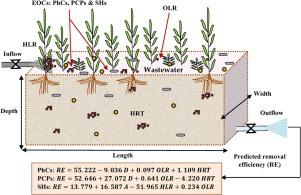Journal of Environmental Chemical Engineering ( IF 7.7 ) Pub Date : 2020-10-10 , DOI: 10.1016/j.jece.2020.104592 Huma Ilyas , Ilyas Masih , Eric D. van Hullebusch

|
This study investigates the prediction of removal efficiency of pharmaceuticals (PhCs), personal care products (PCPs), and steroidal hormones (SHs) based on design and operational parameters (depth, area, hydraulic loading rate-HLR, organic loading rate-OLR, and hydraulic retention time-HRT) of constructed wetlands (CWs). A comprehensive statistical analysis was performed by applying principle component analysis, correlation and multiple linear regression analyses. The data used in this analysis was compiled from peer reviewed publications. The CWs design and operational parameters are good predictors of the removal efficiency of these emerging organic contaminants. Operational parameters (HLR, OLR, and HRT) are the most significant predicators and combination with design parameters (depth and area) often improved reliability of the predictions. The best predictive models for PhCs and PCPs were composed of depth, OLR, and HRT (root mean square errors-RMSEs: training set: 7-14%; test set: 22-27%). A combination of area, HLR, and OLR formed a credible model for predicting the removal efficiency of SHs (RMSEs: training set: 6%; test set: 11%). Similarly, generic models by combining data of PhCs and PCPs, PhCs and SHs, PCPs and SHs, and PhCs, PCPs, and SHs showed acceptable performance. The best performing combined model for the prediction of PhCs, PCPs, and SHs was based on area, HLR, OLR, and HRT (RMSEs: training set: 13%; test set: 22%). The information obtained by the use of these models may guide researchers, practitioners, policy makers, and citizens in enhancing knowledge and understanding for the design and operation of CWs in the field conditions.
中文翻译:

基于人工湿地的设计和运行参数预测新兴有机污染物的去除效率
这项研究根据设计和操作参数(深度,面积,水力负荷率-HLR,有机负荷率-OLR,人工湿地(CW)的水力停留时间(HRT)。应用主成分分析,相关性和多元线性回归分析进行了全面的统计分析。本分析中使用的数据来自同行评审的出版物。连续波的设计和运行参数是这些新兴有机污染物去除效率的良好预测指标。操作参数(HLR,OLR和HRT)是最重要的谓词,并且与设计参数(深度和面积)组合通常可以提高预测的可靠性。PhC和PCP的最佳预测模型由深度,OLR和HRT(均方根误差-RMSE:训练组:7-14%;测试组:22-27%)组成。区域,HLR和OLR的组合形成了预测SH去除效率的可靠模型(RMSE:训练组:6%;测试组:11%)。类似地,通过组合PhC和PCP,PhC和SH,PCP和SH以及PhC,PCP和SH的数据的通用模型显示出可接受的性能。预测PhC,PCP和SH的最佳组合模型是基于面积,HLR,OLR和HRT(RMSE:训练组:13%;测试组:22%)。通过使用这些模型获得的信息可以指导研究人员,从业人员,政策制定者和公民在野外条件下对CW的设计和操作增加知识和了解。



























 京公网安备 11010802027423号
京公网安备 11010802027423号